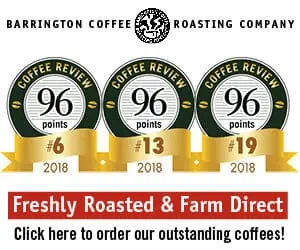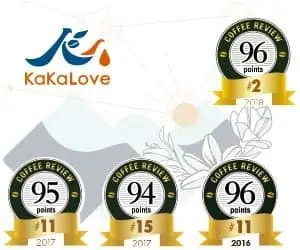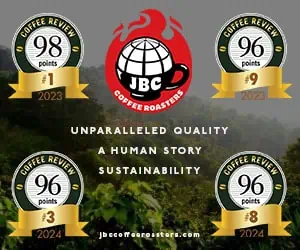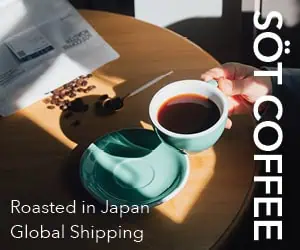Some of the more interesting trends and issues that surfaced among the thirteen prize-winning coffees reviewed this month from the recent Let’s Talk Coffee/Sustainable Harvest HarVee award competition in Panama range from how (the coffees were roasted), to what (tree varieties produced the coffee) to who (produced the coffee). As far as roast goes, we cupped coffees roasted from the far honeyish end of light to the scorchy, cedary end of dark. Tree varieties ranged from the still rare, expensive, and spectacular Gesha/Geisha variety to unnamed mixes of varieties. The prize-winning coffees were grown by high-end technically sophisticated estates, by more traditional family estates, and particularly by cooperatives of small producers.
These coffees were universally fine in their own ways. The green coffees, all imported by Sustainable Harvest, the company sponsoring the event, were consistently taint-free and nicely expressive of variations in region and tree variety. In regard to roast, we cupped no coffees ruined in the roaster by scorching or over roasting; on the other hand we encountered none roasted so ultra-fashionably light that they tasted like an infusion of snap peas and raw sugar cane. And the green coffee producers, whether substantial estates or cooperatives of small holding farmers, all appeared to have built their businesses around soundly sustainable socio-economic and environmental principles.
Nevertheless, there were those coffees that, in our view, rose to the top of their respective award categories, of which there were three: South America, East Africa, and Central America/Mexico.
A list of the thirteen winners broken out by these three categories appears at the end of this article. The reviews themselves appear in order of rating, starting with the highest. All were worthy coffees.
How: The Roast Factor
What distinguished the winners? Let’s start with roast. The current fashion for light roasting showed up in several samples, particular in the three prize-winning Ethiopia coffees, where roasters appeared to be looking for a sweet spot toward the light end of the roast spectrum, presumably to foreground the honey sweetness and giddy floral and cacao-like aromatics characteristic of fine Ethiopias like these. Toward the other end of the spectrum, the Café Moto Nicaragua Las Hermanas (88) was a particularly attractive example of a somewhat darker roast, in which a gentle roast character developed the resonant, low-toned chocolate tendencies of the Nicaragua.
Generally, however, most prize-winners landed somewhere in the broad embrace of a classic medium roast. Terms describing roast style, of course, vary wildly. We at Coffee Review use our version of the simple, straightforward Specialty Coffee Association of America (SCAA) terminology: Very Dark, Dark, Medium-Dark, Medium, Light. We assign these names based on instrument reading of bean color using the M-Basic or “Gourmet” Agtron scale. In the Agtron scale, the higher the number the lighter the roast. If you look at one of our complete, full-page reviews, you will see the roast described by general name (dark, medium, light, etc.) in the column on the left, and the Agtron reading in the column on the right. The Agtron number preceding the slash is the reading for the whole beans before grinding; the number following the slash is the reading for the same coffee after it has been ground. The ground reading, of course, is always higher (lighter) than the whole-bean reading, since the interior of the bean is never as darkly roasted as is the surface. On our Agtron instrument a whole-bean reading of 50 to 55 indicates a classic medium roast, about right in the middle of the roast spectrum. Ultimately dark, almost black “French” roasts may come in whole-bean around 25 or even lower; light-roasted coffees at 60 to 65 whole-bean. Coffees that register whole-bean readings higher than 65 or ground readings exceeding 85 on our instrument usually represent a roast that simply has not developed the interior of the bean, producing a cup that is sweet but veggy and woody.
What: The Variety Issue
A second distinguishing factor among the coffees we tested was tree variety. Generally the winners came from lots consisting of a single variety of tree, almost always a variety known for its sensory distinction. The first-place South America coffee, the 95-rated Blue Bottle Colombia Granja la Esperanza, was produced from trees of the rare, celebrated, pricy Ethiopia-derived Gesha (also Geisha) variety. The Central America and Mexico prize-winner, the 92-rated Equator Guatemala Finca La Valle Antigua, consisted entirely of the heirloom Bourbon variety. The three Ethiopias that took the top three places in the East Africa category, the Blue Bottle (95), Allegro (93) and Gimme Coffee (91), all were produced from the extraordinary local heirloom varieties native to southern and western Ethiopia. If we count the Ethiopias as produced from single-variety lots, then ten of the thirteen prize-winners came from lots consisting entirely of coffee from a single tree variety. Two of the remaining three prize winners also could have come from single-variety lots, though most likely they are mixes of respected though less distinctive-tasting varieties traditional to Latin America.
Who: Size and Sustainability
Sustainable Harvest, as its name suggests, was founded and developed by David Griswold with an emphasis on supporting sustainability in all of its avenues, from certifications like organic and Fair Trade, to the relationship coffee model in which roasters and producers form long-term partnerships, to the growing number of programs and models that, on a more individualized basis, funnel support from roasters and their consumers to coffee-growing communities. Given this emphasis on sustainability and progressive socio-economic practices, it is no surprise that, of the thirteen prize-winning coffees sourced by the roasters from Sustainable offerings, eight were produced by cooperatives of small producers. The remaining five were produced by larger but progressive, mainly family-owned, farms. If we average the winning scores of the larger farm coffees versus the cooperative coffees, it appears that the coops are keeping up fine: The average score for the larger farm coffees was 90.4; the cooperative average was 90.1.
The Gesha Syndrome: Promise or Threat?
During a panel discussion at this year’s Let’s Talk Coffee event on the game-changing nature of the development of the Gesha variety and its spectacular sensory properties, SCAA Executive Director Ric Rhinehart challenged the largely celebratory, self-congratulatory nature of the discussion by pointing out that the Gesha variety, with its startling cup character and high value but daunting technical demands, might represent an opportunity for larger, better-funded producers like those in Panama, but could be seen as one more threat by small-holding producers struggling to survive on one or two hectares elsewhere in Central America.
This certainly is a valid concern, and one that has occurred to me often as I’ve witnessed the rise of the Gesha phenomenon over the past ten years. However, it also appears that cooperatives, working with the vigorous, evolving support system of non-governmental agencies, idealistic roasters and people like those on the Sustainable team itself, may be able to adapt along with the larger farms as the threat of climate change is met by a new wave of innovation and fresh thinking in coffee, all of which was on display in the multi-layered dialogue at this year’s Let’s Talk Coffee event.
Here is the list of award-winners, broken out by category. The reviews of the winners that accompany this article appear in order of rating, from highest to lowest, regardless of category.
HarVee 2014 Roaster Awards for Coffees from South America
First place: 95
Blue Bottle Coffee – Colombia Granja Esperanza Gesha AAA
Second place: 88
Portland Roasting – Los Guardianes Peru FTO
Third place: 87
DCR Coffee (Dillanos Coffee Roasters) – Honey Margarita Colombia
HarVee 2014 Roaster Awards for Coffees from East Africa
First place: 95
Blue Bottle Coffee – Ethiopia Homacho Waeno
Second place: 93
Allegro Coffee – Ethiopia Homacho Waeno
Third place: 91
Gimme Coffee – Ethiopia Wotona Bultuma
Fourth place: 89 (tied)
Allegro Coffee – Rwanda Buremura
Fourth place: 89 (tied)
Nossa Familia Coffee – MIG Washing Station Gikongoro Rwanda
HarVee 2014 Roaster Awards for Coffees from Central America and Mexico
First place: 92
Equator Coffees & Teas – Guatemala Finca El Valle Antigua
Second place: 89 (tied)
Water Avenue Coffee – El Salvador El Manzano Buena Vista
Second place: 89 (tied)
Dillanos Coffee Roasters – Las Lajas Honey Costa Rica Organic
Third place: 88 (tied)
Café Mystique – Mexico FTO
Third place: 88 (tied)
Café Moto – Nicaragua Las Hermanas FTO










